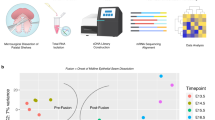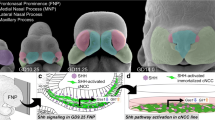Abstract
After palatal fusion, the dorsal and ventral epithelia of the palatal shelf differentiate into the nasal and oral mucosa, respectively. The tissue-specific differentiation of palatal epithelia along the dorsal–ventral axis is regulated by the signaling molecules expressed in the underlying mesenchyme. Thus, as in many other epithelial organs, differentiation relies on epithelial–mesenchymal interactions. To screen for region-specific mesenchymal signaling molecules that determine the fate of the palatal epithelia, we employed a laser microdissection (LMD) method. LMD allowed us to collect region-specific mesenchymal tissues at E13, prior to palatal fusion and the development of distinct dorsal and ventral epithelial morphology. Genome-wide screening was performed on the tissues collected using LMD to identify candidate mesenchymal signaling molecules. The microarray results were validated using real-time quantitative (qPCR) and in situ hybridization methods. The developmental role and interactions of the candidate genes were evaluated in in vitro-cultivated E13 palates using an anti-sense oligodeoxynucleotide (AS-ODN)-based loss-of-function approach. Apparent changes in the expression patterns of Runt-related transcription factor 2 (Runx2) and LIM homeobox 8 (Lhx8) were observed after knocking down each gene. Knock-down of Runx2 and Lhx8 also altered the immunolocalization pattern of cytokeratin18 (CK18), an established marker for nasal epithelium. These results were confirmed using Runx2 heterozygote mice. The mesenchymal signaling molecules Runx2 and Lhx8, which possess region-specific expression patterns along the dorsoventral axis, functionally interact to regulate the cellular and molecular characteristics of dorsal and ventral epithelia, suggesting that mesenchymal signaling molecules determine the dorsoventral fate of epithelial structures in the developing palate.






Similar content being viewed by others
References
Alappat SR, Zhang Z, Suzuki K, Zhang X, Liu H, Jiang R, Yamada G, Chen Y (2005) The cellular and molecular etiology of the cleft secondary palate in Fgf10 mutant mice. Dev Biol 277:102–113
Bindea G, Galon J, Mlecnik B (2013) CluePedia Cytoscape plugin: pathway insights using integrated experimental and in silico data. Bioinformatics 29(5):661–663
Bjork BC, Turbe-Doan A, Prysak M, Herron BJ, Beier DR (2010) Prdm16 is required for normal palatogenesis in mice. Hum Mol Genet 19:774–789
Carette MJ, Lane EB, Ferguson MW (1991) Differentiation of mouse embryonic palatal epithelium in culture: selective cytokeratin expression distinguishes between oral, medial edge and nasal epithelial cells. Differentiation 47:149–161
Chai Y, Maxson RE Jr (2006) Recent advances in craniofacial morphogenesis. Dev Dyn 235:2353–2375
Cho KW, Kim JY, Song SJ, Farrell E, Eblaghie MC, Kim HJ, Tickle C, Jung HS (2006) Molecular interactions between Tbx3 and Bmp4 and a model for dorsoventral positioning of mammary gland development. Proc Natl Acad Sci U S A 103:16788–16793
Chokechanachaisakul U, Kaneko T, Okiji T, Kaneko R, Suda H, Nor JE (2010) Laser capture microdissection in dentistry. Int J Dent 2010:592694
Chuong CM, Widelitz RB, Ting-Berreth S, Jiang TX (1996) Early events during avian skin appendage regeneration: dependence on epithelial-mesenchymal interaction and order of molecular reappearance. J Investig Dermatol 107:639–646
Chuong CM, Jung HS, Noden D, Widelitz RB (1998) Lineage and pluripotentiality of epithelial precursor cells in developing chicken skin. Biochem Cell Biol 76(6):1069–1077
Ferguson WJ (1984) Epithelial-mesenchymal interactions during vertebrate palatogenesis. Curr Top Dev Biol 19:137–164
Han J, Mayo J, Xu X, Li J, Bringas P Jr, Maas RL, Rubenstein JL, Chai Y (2009) Indirect modulation of Shh signaling by Dlx5 affects the oral-nasal patterning of palate and rescues cleft palate in Msx1-null mice. Development 136:4225–4233
He F, Xiong W, Wang Y, Matsui M, Yu X, Chai Y, Klingensmith J, Chen Y (2010) Modulation of BMP signaling by Noggin is required for the maintenance of palatal epithelial integrity during palatogenesis. Dev Biol 347:109–121
Jeong JH, Jung YK, Kim HJ, Jin JS, Kim HN, Kang SM, Kim SY, van Wijnen AJ, Stein JL, Lian JB, Stein GS, Kato S, Choi JY (2010) The gene for aromatase, a rate-limiting enzyme for local estrogen biosynthesis, is a downstream target gene of Runx2 in skeletal tissues. Mol Cell Biol 30(10):2365–2375
Jin JZ, Tan M, Warner DR, Darling DS, Higashi Y, Gridley T, Ding J (2010) Mesenchymal cell remodeling during mouse secondary palate reorientation. Dev Dyn 239:2110–2117
Kerman IA, Buck BJ, Evans SJ, Akil H, Watson SJ (2006) Combining laser capture microdissection with quantitative real-time PCR: effects of tissue manipulation on RNA quality and gene expression. J Neurosci Methods 153:71–85
Lee JM, Kim JY, Cho KW, Lee MJ, Cho SW, Zhang Y, Byun SK, Yi CK, Jung HS (2007) Modulation of cell proliferation during palatogenesis by the interplay between Tbx3 and Bmp4. Cell Tissue Res 327:285–292
Lee JM, Kim JY, Cho KW, Lee MJ, Cho SW, Kwak S, Cai J, Jung HS (2008) Wnt11/Fgfr1b cross-talk modulates the fate of cells in palate development. Dev Biol 314:341–350
Miettinen PJ, Chin JR, Shum L, Slavkin HC, Shuler CF, Derynck R, Werb Z (1999) Epidermal growth factor receptor function is necessary for normal craniofacial development and palate closure. Nat Genet 22:69–73
Peters H, Neubuser A, Kratochwil K, Balling R (1998) Pax9-deficient mice lack pharyngeal pouch derivatives and teeth and exhibit craniofacial and limb abnormalities. Genes Dev 12:2735–2747
Rice R, Spencer-Dene B, Connor EC, Gritli-Linde A, McMahon AP, Dickson C, Thesleff I, Rice DP (2004) Disruption of Fgf10/Fgfr2b-coordinated epithelial-mesenchymal interactions causes cleft palate. J Clin Invest 113:1692–1700
Sohn WJ, Ji YR, Kim HS, Gwon GJ, Chae YM, An CH, Park HD, Jung HS, Ryoo ZY, Lee S, Kim JY (2012) Rgs19 regulates mouse palatal fusion by modulating cell proliferation and apoptosis in the MEE. Mech Dev 129:244–254
Tyler MS, Pratt RM (1980) Effect of epidermal growth factor on secondary palatal epithelium in vitro: tissue isolation and recombination studies. J Embryol Exp Morpholog 58:93–106
Wang WZ, Oeschger FM, Lee S, Molnar Z (2009) High quality RNA from multiple brain regions simultaneously acquired by laser capture microdissection. BMC Mol Biol 10:69
Widelitz RB, Jiang TX, Noveen A, Ting-Berreth SA, Yin E, Jung HS, Chuong CM (1997) Molecular histology in skin appendage morphogenesis. Microsc Res Tech 38:452–465
Xu J, Krebs LT, Gridley T (2010) Generation of mice with a conditional null allele of the Jagged2 gene. Genesis 48:390–393
Zhang Z, Song Y, Zhao X, Zhang X, Fermin C, Chen Y (2002) Rescue of cleft palate in Msx1-deficient mice by transgenic Bmp4 reveals a network of BMP and Shh signaling in the regulation of mammalian palatogenesis. Development 129(17):4135–4146
Zhao Y, Guo YJ, Tomac AC, Taylor NR, Grinberg A, Lee EJ, Huang S, Westphal H (1999) Isolated cleft palate in mice with a targeted mutation of the LIM homeobox gene lhx8. Proc Natl Acad Sci U S A 96(26):15002–15006
Acknowledgments
This study was supported by a National Research Foundation of Korea (NRF) grant funded by the Korean Government (MSIP; no. 2008–0062282) and the National Research Foundation of Korea (grant NRF-2012R1A1A2044113 and NRF-2010-0004243) funded by the Ministry of Education, Science and Technology, Republic of Korea. This research was supported by Kyungpook National University Research Fund, 2012.
Author information
Authors and Affiliations
Corresponding author
Additional information
Wern-Joo Sohn and Gi-Jeong Gwon contributed equally to this work.
Electronic supplementary material
Below is the link to the electronic supplementary material.
Supplementary Figure 1
Altered histogenesis and localization patterns of CK18 and Lhx8 in Runx2 heterozygote embryo palate at E13.5. (A, D) HE staining. (B, E) CK18 localization pattern in palatal shelf. (C,F) Expression pattern of Lhx8 in palatal mesenchyme. (GIF 213 kb)
Rights and permissions
About this article
Cite this article
Sohn, WJ., Gwon, GJ., Kim, HS. et al. Mesenchymal signaling in dorsoventral differentiation of palatal epithelium. Cell Tissue Res 362, 541–556 (2015). https://doi.org/10.1007/s00441-015-2222-8
Received:
Accepted:
Published:
Issue Date:
DOI: https://doi.org/10.1007/s00441-015-2222-8




